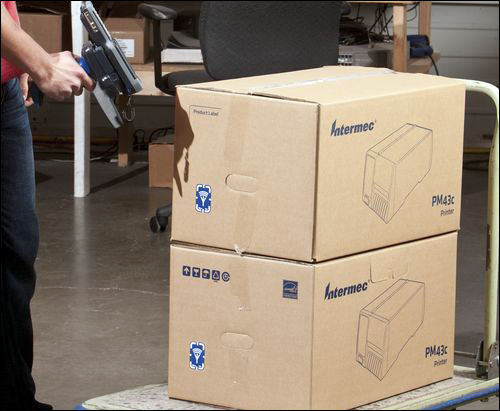Intermec recently announced plans to release two printer models that can be configured wirelessly using a handheld RFID reader. Both the PM43 printer and a more compact version, the PM43c, come with optional functionality, known as No-Touch Configuration, enabled by an ultrahigh-frequency (UHF) EPC Gen 2 EM4325 RFID chip from EM Microelectronic, embedded in the device. The configurable thermal printers are expected to be made commercially available in September 2012, though several companies are already testing the RFID technology, by configuring the devices to print specific types of labels, and to specify the Ethernet and interface settings. Both products are mid-range industrial printers, intended for applications within distribution centers and manufacturing environments to print bar codes, text or images. Intermec can also incorporate optional RFID interrogators into the printers, for customers looking to encode RFID labels.
The two printers are designed to be “super-reliable, super-performance and super-ready,” says Tom Roth, Intermec’s senior director of printer product management, with the RFID configuration function providing the “super-ready” component.
By making the printers capable of quick configuration with an RFID reader, the firm hopes to reduce the number of labor hours its customers spend setting up large quantities of printers they have purchased. According to Intermec, No-Touch Configuration can be used to set up 20 printers in less than 5 percent of the time it would typically take using traditional methods. Often, a business may purchase hundreds or thousands of printers, configure them all at a central location and then ship them to various facilities, such as stores or offices located throughout the world.

Configuration can include preset IP addresses to which the printer can be linked, as well as the language for the user interface—such as Mandarin for printers bound for a site in China. To undertake the configuration of every machine, says Alex Babic, Intermec’s manager of printer products, companies typically deploy staff members to open each box, power up the printer, press necessary prompts in order to configure that device, and then turn off and repack the machine. Deploying 50 printers, he says, could require an entire day’s worth of work.
With the built-in RFID tag and an Intermec handheld RFID reader product (or any other EPC Gen 2 UHF handheld interrogator), the operation becomes much simpler, the company reports. The customer would need to purchase No-Touch Configuration Windows Mobile-based software from Intermec, which would enable that user to select such configuration details as the IP address, and to then transmit those instructions to the printer’s RFID tag. When the printer is later turned on, it can then pull data directly off its tag and configure itself according to the encoded directives.
This process can be accomplished through a closed box, Roth says. What’s more, if multiple printers are destined for a single location, and are thus likely to require the same configuration, the software can be programmed to encode the same instructions to each printer’s tag. If there are several groupings of readers—for example, five bound for one location, and 10 destined for another—the software also enables the user to set several configuration templates, and to select the appropriate one upon reading the printer’s tag ID via the handheld.
In addition, the user can track configuration events, thereby storing data indicating how specific printers were configured—and, therefore, when they were being prepared for shipment to the site where they would be installed.
EM Microelectronic’s recently released EM4325 integrated circuit offers several advantages for this application, according to Rene Martinez, Intermec’s chief technologist. The IC can operate in either passive or battery-assisted passive (BAP) mode. For customers opting for No-Touch Configuration, Intermec will install the 4-kilobit chip with a battery. By default, the integrated circuit utilizes the BAP mode to enhance RFID read performance. In the event that the internal battery fails, the chip will continue operating as a fully passive tag, though at a reduced read distance. If the printer is switched on, the chip’s operation will be assisted by power supplied by that device. The IC also comes with an internal temperature sensor, but that function is not presently in use with the No-Touch Configuration application.



